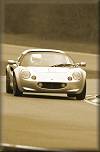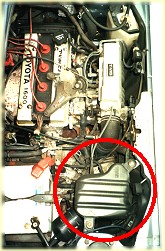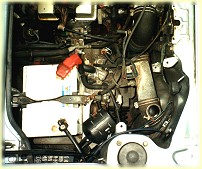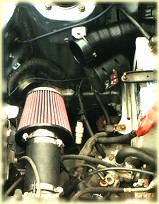
MENU
|
MR2 K&N Air Filter
15th May 1999
After fitting a standard Toyota exhaust, the easiest route to more power was to replace the air
 induction/filter system. I chose the K&N 57i as it seemed a sensible choice and was available
in kit form for the MR2. My car is a "late" model which means it has the air filter in the boot (inside the nearside wing). The K&N kit for the late MkI is model number 57-0120, early models are number 57-0053. If you're ordering from a catalogue like Demon Tweeks be careful which model you order as they often list just the one (cheaper) model.
induction/filter system. I chose the K&N 57i as it seemed a sensible choice and was available
in kit form for the MR2. My car is a "late" model which means it has the air filter in the boot (inside the nearside wing). The K&N kit for the late MkI is model number 57-0120, early models are number 57-0053. If you're ordering from a catalogue like Demon Tweeks be careful which model you order as they often list just the one (cheaper) model.
[click on any of the pictures below for a high-res version]
As well as the cone filter, the kit comes with the correct pipes to attach to the throttle body (T-VIS unit), a cold air intake hose and the relevant clips and bolts to put it all together. Oh, and you also get a window sticker (as above). The instructions look intimidating but once underway, I found them easy to follow and the whole job took me about 2 hours.
 The first thing to do is remove the big air resonator box (branded Denso).
This comes away after removing the two 12mm bolts - shown at 2 o'clock and 7 o'clock in the red circle. To remove the box from the hose below, you need to find the jubilee clip and loosen it
with a 10mm socket. Twist the box off and you can see the all of the original plumbing.
This all needs to be removed but first you need to disconnect the sensors and hoses that connect to the metal pipe.
The first thing to do is remove the big air resonator box (branded Denso).
This comes away after removing the two 12mm bolts - shown at 2 o'clock and 7 o'clock in the red circle. To remove the box from the hose below, you need to find the jubilee clip and loosen it
with a 10mm socket. Twist the box off and you can see the all of the original plumbing.
This all needs to be removed but first you need to disconnect the sensors and hoses that connect to the metal pipe.
 The K&N instructions make this clear but this picture shows what needs to be removed. Here's a picture with all of the original plumbing removed, you should seal off the hole leading to the boot air filter (circled) to stop rubbish from gathering. I opted to keep the original filter in place but you can also take it all out to give yourself some more boot space.
The K&N instructions make this clear but this picture shows what needs to be removed. Here's a picture with all of the original plumbing removed, you should seal off the hole leading to the boot air filter (circled) to stop rubbish from gathering. I opted to keep the original filter in place but you can also take it all out to give yourself some more boot space.
Now comes the good part - fitting the K&N cone filter. The kit comes
with a short length (~90mm)
 of rubber tubing to connect to the throttle body. There is also a small metal pipe with which to
connect the filter to the rubber tubing. Fit the metal pipe to the
filter first (as there is a lip inside the filter to stop the metal pipe
at the correct place). Then fit the filter with metal pipe to the
rubber tubing. The miscellaneous sensors and connectors can now be
re-connected. You use the original air box bracket (2 o'clock position)
to attach the main sensor
housing using a nut and bolt provided in the kit. The K&N
instructions suggest that you use an extra long length of small tubing
to connect from the sensor housing to the throttle body, however, I found
that the bore of the tubing provided was too large. The original item
was long enough to fit from the new sensor housing position. The two
remaining sensor plugs fit into two correctly-sized holes on the rear of
the filter. That's it! The filter is now ready, all that's left
to do is install the cold air intake system.
of rubber tubing to connect to the throttle body. There is also a small metal pipe with which to
connect the filter to the rubber tubing. Fit the metal pipe to the
filter first (as there is a lip inside the filter to stop the metal pipe
at the correct place). Then fit the filter with metal pipe to the
rubber tubing. The miscellaneous sensors and connectors can now be
re-connected. You use the original air box bracket (2 o'clock position)
to attach the main sensor
housing using a nut and bolt provided in the kit. The K&N
instructions suggest that you use an extra long length of small tubing
to connect from the sensor housing to the throttle body, however, I found
that the bore of the tubing provided was too large. The original item
was long enough to fit from the new sensor housing position. The two
remaining sensor plugs fit into two correctly-sized holes on the rear of
the filter. That's it! The filter is now ready, all that's left
to do is install the cold air intake system.
The cold air intake system is simply a length of flexible
 hose that feeds air from below the car up to the engine bay for the
filter to draw from. Cold air is better than the warm air in the engine
bay because it is denser. First you need to expand the length of
provided flexible hose to it's maximum size (~90cm). Then feed it
behind the battery to the bottom of the engine bay. I used two cable
ties provided to attach each end to a suitable point. I used the other
original air box bracket to fix the engine-end of the hose directing
cold air into the direction of the filter. To attach the underside-end
of the hose, I needed to jack the car up on the nearside before I could
find a suitable location. The K&N instructions got a little complicated
at this point so I made an educated guess.
hose that feeds air from below the car up to the engine bay for the
filter to draw from. Cold air is better than the warm air in the engine
bay because it is denser. First you need to expand the length of
provided flexible hose to it's maximum size (~90cm). Then feed it
behind the battery to the bottom of the engine bay. I used two cable
ties provided to attach each end to a suitable point. I used the other
original air box bracket to fix the engine-end of the hose directing
cold air into the direction of the filter. To attach the underside-end
of the hose, I needed to jack the car up on the nearside before I could
find a suitable location. The K&N instructions got a little complicated
at this point so I made an educated guess.
Here's a picture of my engine bay before and after.
In use, there are some odd induction noises as you apply the throttle below 3000rpm. There is a high-pitched whoosh/sucking noise as you apply the throttle and make a demand on air. Above 3000rpm however, the engine note takes on a much more purposeful tone. Up until the T-VIS kicks in at about 4500rpm the engine seems to have better throttle response and a lower, raspier noise. But it's above 4500rpm with the T-VIS in full swing that the K&N really makes itself known. The noise is just terrific; a real race-car induction note. Upshifts at the redline when the engine speed drops back to ~5000rpm are extremely satisfying. I think there's more power, it's hard to be objective about it when that noise makes it feel as if you're really making progress. Refinement is largely maintained, as the induction noise is related to air intake and therefore the amount of throttle applied. Trundling around town, the only extra noise is the whoosh as you apply the throttle. Motorway driving is noisier during acceleration but once at a steady speed, there's no extra noise with a small throttle opening. On the open road using maximum throttle you get the real benefit of efficient air intake - the power and the noise, just when you need it!
25th May 1999
Another plus point is that I've gained an extra 2-3mpg, making a tank of fuel go another 25 miles :-)
26th May 1999
However, there is a downside. Between 3700 and 4600rpm there is a really annoying chirruping whistle. It's as if that there's an excess of air in the intake system that's turbulent and forcing itself back out. As soon as the second butterfly valve opens up on the T-VIS unit, the whistle is replaced with the satisfying induction note described above. I've tried to use the 90° bend that came off the original setup just in case that solved the problem but without success. I'm now going to try to extend the length of intake hose and introduce a slight bend so that the filter sits next to where the original system entered the engine bay. Then by removing the old filter from the housing in the boot, the original intake system becomes the cold-air system. Also, with the longer hose and having the filter lower in the engine bay, if the whistle persists, it should at least be quieter. Now, I know none of this will help performance (or economy) but I don't think I can put up with this noise for much longer!
28th May 1999
I called K&N UK about the whistling noise. They said that although it wasn't uncommon (prevalent on Honda VTEC's apparantly), they hadn't heard of it on an MR2. The guy said that it was basically a random phenomenon where resonance is created between the filter and intake body. The air resonator box in the original system would remove any such noise. Perhaps that's why the late MkI's have the resonator box and the early models don't? Maybe early MkI's were prone to resonance in the intake system.
31st May 1999
Well I solved the problem... By making the system less efficient, I've reduced the whistle to an almost inaudible level. I used the two 90° bends from the original system and the length of rubber hose from the K&N kit to site the filter lower in the engine bay, next to where the original system went through to the boot. By doing this, the filter sits directly underneath the louvre on the engine cover, exposing it to rain. A simple solution to this was to re-install the air resonator box over the filter. I'm also experimenting with the cold air system. I removed the filter element from the original filter housing in the boot to allow airflow through to the engine bay (in line with the new filter location). I'll need to see whether I gather water in the original filter housing. If so, then I'll seal it up again and use the flexi-hose that came with the K&N kit.
With all this in place, the sound from the K&N system is very subdued. Although the noise is still more purposeful than the original system, the T-VIS induction note is not nearly as exciting. The low-rev burble is also gone. However, the whoosing and whisting have all but disappeared. A side affect of this is that the power characteristics have changed somewhat. There is noticably less power at the top end of the rev-range but increased response from the mid-range that was previously the flat spot. I might see about giving the throttle body a clean out in case the butterflies are the cause of the squeaky whistle.
11th June 1999
I removed the throttle body and gave it a good blast with carb cleaner. I was amazed at how much sludge was there. It took me a good 30 minutes to clean the thing out properly. With the throttle body removed, I was able to have a good look inside the T-VIS unit. This doesn't look too clean either. The PCV hose from the engine block can bring vapours back into the throttle body. After replacing the cleaned throttle body, I re-installed the K&N kit as per the original layout. The sqeak returned and seemed noisier than ever. The high-rev induction note wasn't as impressive as I had remembered it either. I have now reverted to my hybrid plumbing as described above. Time to visit my mechanic again...
30th August 1999
It will soon be time to sell the car to make way for my forthcoming Lotus Elise. To this end, I have put the K&N back in the box and reinstalled the original air filter system. But before I did this, I had one last fiddle with the K&N setup. I started off with the K&N in it's intended position just off the throttle body. The annoying whistle returned but I noticed a couple of other points. Firstly top-end power is increased but at the expense of low-end torque and secondly, it didn't sound as good as my hybrid setup.
Next, to try to remove the whistle, I managed to put the K&N in place with the resonator box up near the throttle body. I really thought that the resonator box would cut down on the whistling but it made no discernable difference to the standard K&N layout. My final option was to put all of the engine-bay plumbing back in place and locate the K&N filter in the boot. Again, this didn't stop the whistling (although it was somewhat quieter) and it made quite an interesting noise as sound boomed through the boot space.
So I put the original air filter back in place and was amazed at the result - simply bags and bags of low-end grunt. Top-end power is definately down but the car is much more enjoyable to drive in traffic. Coupled with the refinement of a much quieter engine note, I'm enjoying driving the car more than ever.
|
© 30-Aug-1999 |